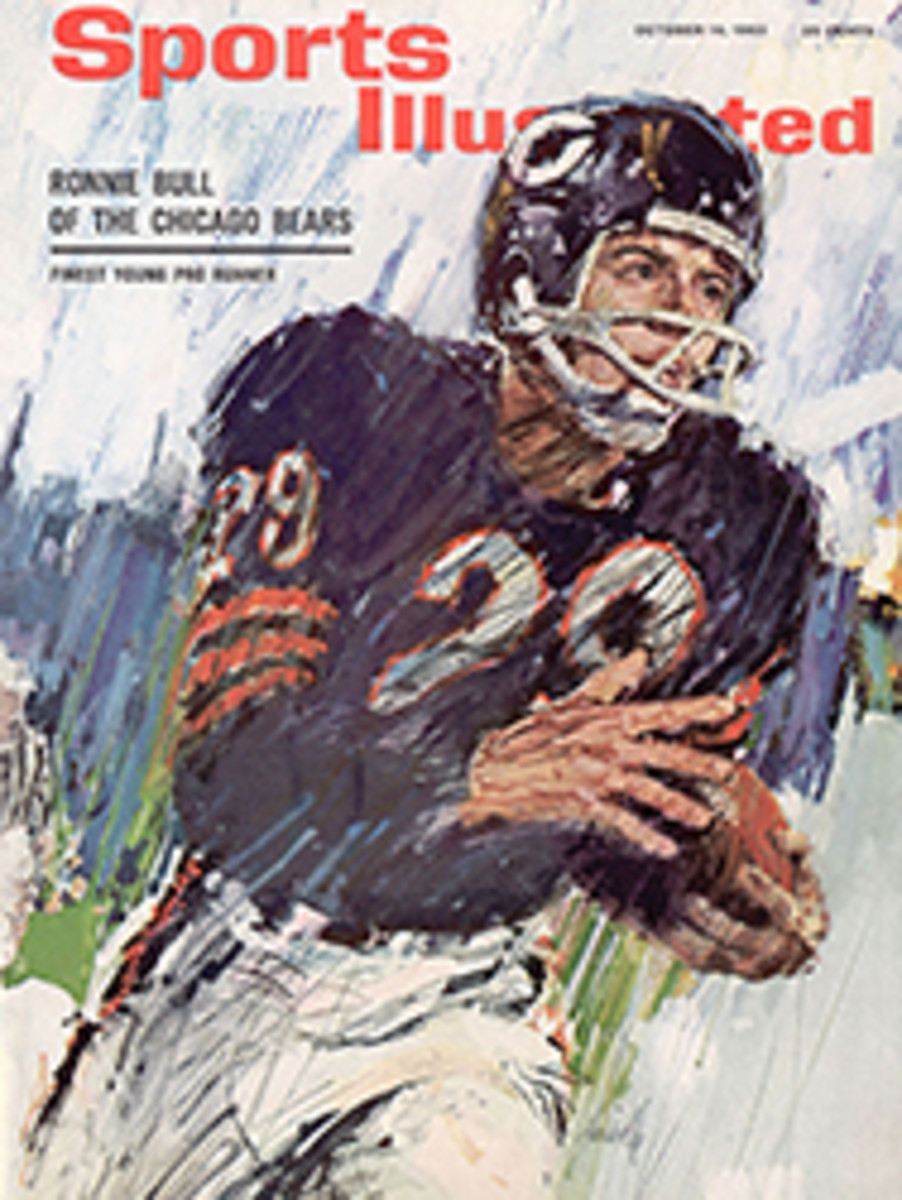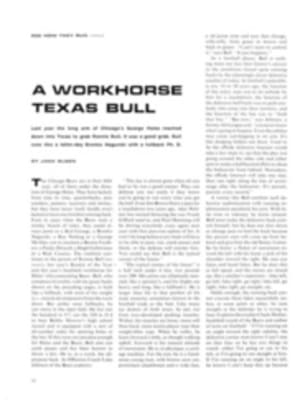
19TH HOLE: THE READERS TAKE OVER
SEMPER FIDO
Sirs:
I think Myron Cope did a fine job on Fido Murphy (Football's Greatest Scout, Sept. 30), but I would like to set him straight on one detail. St. Viator did play Moose Krause's St. Mary's team in a night football game indoors. I know because I quarter-backed St. Viator's. I had a cast on my left arm, but Murphy had me in there anyway, to do the punting. He said I was too valuable to be sitting this one out.
Fido Murphy is really a great fellow and has done a lot for me.
ALFRED PALLADINO
Bristol, Conn.
Sirs:
As I anticipated, Fido phoned as soon as I returned from New York. He said the story was good, and his wife got on the phone and called me a genius, but Fido was deeply wounded by one thing in the story. We quoted Moose Krause as saying that Fido was mistaken in relating that his St. Viator team played Moose's team in the first indoor football game in history. Krause said his team played St. Benedict's College, coached by Moon Mullins. Fido says that the game Moose was referring to didn't take place until the following year and that his team most certainly had played Krause's team in the first indoor game. "Now all the sports-writers will think I'm a phony," Fido shouted at me through the phone.
MYRON COPE
Pittsburgh
Sirs:
Please retract statement made by Moose Krause on page 34 of your September 30 issue.
When I thought up playing St. Mary's College of Winona, Minn. indoors at 52nd and Cottage Grove in 1934, which was a success financially for St. Viator College where I was the head coach, I consider it one of my pride and joys and better accomplishments in football and demand the truth printed.
In fact, Marchie Schwartz asked me that night at half time to go easy on Krause, because he was an outstanding athlete at De La Salle Academy and at Notre Dame, and that night was the first time his Chicago following saw him as a coach.
The next year (1935) St. Benedict's College of Kansas played that indoor game after my brainchild of the year before.
My players who played for me in that 1934 indoor game are calling me from all parts of the nation; therefore, please make a correction.
RAY (FIDO) MURPHY
Burbank, Calif.
GOURMET'S WAHOO
Sirs:
As a sometime fisherman who was nursed through his first wahoo by Roy Taylor, I protest Jack Olsen's depreciation of the gastronomic value of this game fish (Wahoo, Sept. 30). Joy unbounded comes as you watch the leaping strike on a trolled bonefish or gar, excitement as he strips 100 yards from the reel, anguish as you "horse" him in to beat the following shark; but the fillip of anticipation of broiled or barbecued wahoo really makes the day. Bermuda rockfish and broiled dolphin filets are the only palate pleasures that approach these dishes.
ROBERT KOLLMAR, M.D.
Short Hills, N.J.
50-MILE GIRLS
Sirs:
We of the Amarillo Sailfish Aquatic Club wish to extend our appreciation for the fine article that was written about our 50-mile swim (SCORECARD, Sept. 16). But the girls of our team make a protest. You indicated that only boys swam. There were many fine girls swimming in this endeavor; I am included. The girls ranged in age from 8 to 16.
CONNIE SMITH
Amarillo, Texas
WAIT'LL NEXT DECADE
Sirs:
I would like to commend you for your very comprehensive and direct article (Why Can't We Beat This Girl? Sept. 30).
The plain, simple fact is that as long as we provide virtually no programs for our American girls, and as long as we discourage their participation and defend their defeat by saying, "Ladies should not perspire or show signs of physical stress or strain!" we shall continue to get clobbered. If we hope to go ahead and produce a winner in the area of women's track and field, we must institute changes in practice, philosophy and policy. There are in America thousands and thousands of girls who would be willing to pay the price necessary to represent this country internationally. We never hear of them or from them, because we don't expose them to the sport.
Somewhere between the Atlantic and the Pacific, between the Canadian and the Mexican borders, there is a women's track-and-field team that can win for America and that Americans can be proud of. I believe that we should find that team—now!
JIM BEATTY
Pasadena, Calif.
Sirs:
I am in junior high and am avidly interested in track and field. But, is there any way I can really compete, without competing on the national level? No, not to speak of. Our school does have a meet with a few other junior high schools once a school year. Seeing as how this is an annual event, one would think it would be a really big event. It isn't. We have a grand total of four events—softball throw, broad jump, high jump and 50-yard dash. This can hardly be called a "track meet."
As for class instruction, more emphasis should be placed on track and field—competitive and recreational aspects. With more training, more champions can be developed. The saying, "Champions are made, not born" still holds. Junior high is not too young to start.
MARILYN TABOR
Bethesda, Md.
Sirs:
Finally, someone has come out for improvement in girls' athletics.
It has been proved time and again that physically fit females are happier, do better in the classroom and make better mothers. Yet, our educators make no provisions for girls' athletics.
The physical education people consider it drudgery to coach girl athletes, and few, if any, male coaches want the job. The girls' teams show this neglect in a lack of fundamental knowledge of the sport.
Girls' athletics can be exciting and hold spectator interest if we will forget that females are fragile packages that must be protected and coddled at all times. Girls tolerate a rigorous training schedule as well as boys, but many coaches fear that they will overwork girls and hence be left open to criticism. Let's give the girls the same playing rules as the boys and forget this double standard. Let's give them a real chance to run and play; then we will have Olympic teams that will be a credit to our country.
FRANK E. BARNES JR., M.D.
Smithfield, N.C.
Sirs:
Ten years from now, possibly a little sooner, American girls may be able to beat a Russian girl like Valentina Maslovskaya. There really isn't anything the matter with American girls that the education of parents, school administrators, school boards, physical educators, the medical profession, writers for popular magazines—and American girls—couldn't fix. But it will take that long. The chances for our present crop are gone.
It wasn't just the exclusion of physical educators from participation in Olympic planning in 1928 that destroyed track and field as well as practically everything else of value in girls' physical education. Of far more importance was the misinterpretation of educational theories. This lack of understanding led them to scrap calisthenics as dull and regimented. Next, apparatus and tumbling were shelved. Gymnastics, the builder of basic bodies, arm, hand, shoulder, back and chest strength and the all-important flexibility so necessary to later skills, suddenly became too "hard" for children—and worse, "too dangerous." With hardly a ripple we dropped the black ink of fear into our entire school population—and it has been there ever since. This attitude exists only in America.
Freud's theory that many neuroses originated in childhood meant, they thought, that children had to be kept "happy" at all costs. So competition was outlawed (the losers wouldn't be "happy"). Sweat and strain imply discomfort, and discomfort isn't a "happy" state. The children could play on their own time. The trouble was they didn't, for this was the start of the radio-TV era. This thievery of time exists to this day. Put a stopwatch on your boy or girl in P.E. when he is engaged in actual body-building activities and you will find that, unless he is varsity or she is a cheerleader, it comes to about 13 minutes a week. How far do you think kids would get with 13 minutes of math a week? Bad as this is for boys, it is even worse for girls.
The best years for physical development and for the development of drive and courage are the first six. The second important period is from 6 to 12. At the time the first Council on Youth Fitness was formed in 1955,91% of our elementary schools did not even have a gym. After sputnik went up, school boards even scrapped some of those that existed to make more space for labs.
But a new time is at hand. At the New York State University in Cobleskill, N.Y., nursery school teachers are learning to teach real physical fitness classes to 2-, 3-and 4-year-olds. (Why do our skaters and swimmers do well in international competition? They start young, they work hard and someone is interested.)
The young teachers work with their small pupils on tumbling, calisthenics and apparatus. The children climb, jump, lift, push and run. Gone are the naps, gone the pampering and gone the chance to watch. In those classes every child does—and the teacher does. No wonder that they get and keep good-looking bodies—examples little ones can follow.
It's a strange thing, but all this hard work turns out to be fun. The children love it, they improve, they are proud of themselves and they are "happy." Those little people are on the way to healthy bodies that will support healthy minds capable of hard work and considerable accomplishment.
BONNIE PRUDDEN
President, Institute for Physical Fitness
New York City

